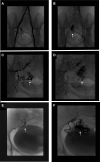Acquired uterine arteriovenous malformation in a patient with cornual pregnancy: A case report
- PMID: 36451408
- PMCID: PMC9704990
- DOI: 10.1097/MD.0000000000031629
Acquired uterine arteriovenous malformation in a patient with cornual pregnancy: A case report
Abstract
Introduction: Acquired uterine arteriovenous malformation (uAVM) is a rare disease and could occur after dilation and curettage, cesarean section, or neoplastic processes.
Patient concerns: A 29-year-old female presented with acute right lower abdominal pain and positive beta human chorionic gonadotropin (β-hCG).
Diagnosis: A 6 cm ectopic right cornual pregnancy was found on ultrasound examination.
Interventions: She underwent a laparoscopic resection of the cornual ectopic pregnancy. She returned with extensive vaginal bleeding 6-month post surgery, and eventually diagnosed with arteriovenous malformation at the previous surgical site by Color Dopplor endovaginal ultrasound. Percutaneous transcatheter uterine artery embolization (UAE) was attempted, however, vaginal bleeding continued. She was taken to the operation room for a hysteroscopic ablation of uAVM.
Outcomes: Complete cessation of the bleeding was achieved without hysterectomy.
Conclusion: We report an extremely unusual case of acquired uAVM after a wedge resection of cornual pregnancy. Ultrasound evaluation of patients with post-operative persistent bleeding should be considered for evaluation of a possible arteriovenous malformation.
Copyright © 2022 the Author(s). Published by Wolters Kluwer Health, Inc.
Conflict of interest statement
The authors have no conflicts of interest to disclose.
Figures





References
-
- Moawad NS, Mahajan ST, Moniz MH, et al. . Current diagnosis and treatment of interstitial pregnancy. Am J Obstet Gynecol. 2010;202:15–29. - PubMed
-
- Lau S, Tulandi T. Conservative medical and surgical management of interstitial ectopic pregnancy. Fertil Steril. 1999;72:207–15. - PubMed
-
- Grivell RM, Reid KM, Mellor A. Uterine arteriovenous malformations: a review of the current literature. Obstet Gynecol Surv. 2005;60:761–7. - PubMed
-
- Takeda A, Koyama K, Imoto S, et al. . Progressive formation of uterine arteriovenous fistula after laparoscopic-assisted myomectomy. Arch Gynecol Obstet. 2009;280:663–7. - PubMed
-
- Timor-Tritsch IE, Haynes MC, Monteagudo A, et al. . Ultrasound diagnosis and management of acquired uterine enhanced myometrial vascularity/arteriovenous malformations. Am J Obstet Gynecol. 2016;214:731 e1–e10. - PubMed
Publication types
MeSH terms
LinkOut - more resources
Full Text Sources
Medical

